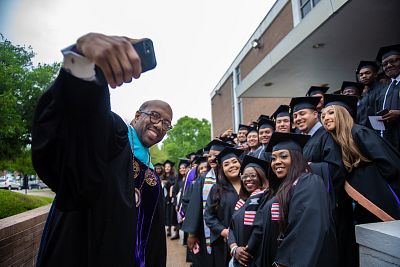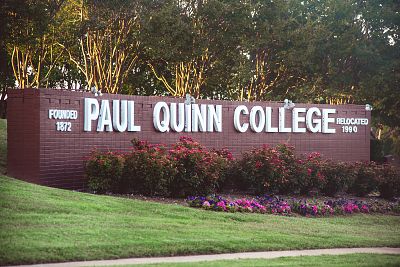"When these institutions were created they weren't created on equal footing with historically white institutions," one expert said.
When Michael Sorrell became president of Paul Quinn College 12 years ago, he assessed the dire situation his school was in and made a bold choice: No more football.
"I mean, we're in Texas. We're an HBCU in Texas," Sorrell said. "I got a little flak for that, okay?"
But to him, eliminating the program was the only way the historically black college, which was founded in 1872 by a group of preachers from the African Methodist Episcopal Church to educate freed slaves and their children, could get back on track.
Football had cost the Dallas school roughly $600,000 to a million dollars a year, he said, and scholarships went mainly to the players. Meanwhile, other students struggled, faculty and staff were leaving, and buildings had fallen into disrepair.
"We were roughly 18 months to 24 months away from closing. We had financial problems. We had academic problems. We had morale problems, and it was the prototypical scenario for an institution that had been struggling for a long time and the end of the road was coming," he told NBC News in a phone interview.
The challenges Paul Quinn College faced are not unique, experts said, even if its solution was one of a kind.
Last month, when billionaire philanthropist Robert Smith thrust historically black colleges and universities (HBCUs) into the national spotlight by pledging to eliminate up to $40 million in student loans for Morehouse College's almost 400 graduates, his gift was heralded as both historic and likely life-changing for those students.
But student loan debt is merely a symptom of a systemic problem that dates back to the schools' beginnings, according to Marybeth Gasman, a professor at the University of Pennsylvania and an expert on HBCUs.
"When these institutions were created they weren't created on equal footing with historically white institutions," she said. "So what happens is basically you end up with a situation where the majority (white) institutions continue to get wealthier because wealth begets wealth, and the HBCUs are behind."
HBCUs were founded and subsidized by states, the federal government, philanthropists or churches to educate black Americans who were barred from attending majority-white colleges. But in recent years, financial woes, among other issues, have forced a number of the schools to the brink of closure or put their accreditation at risk. And, lacking large endowments for generous scholarships compared to many non-HBCUs, much of the burden can fall on the students to depend on substantial loans to make up gaps in aid.
Gasman said that more than 70 percent who attend HBCUs rely on federal Pell Grants, which is aid for students who demonstrate financial need. But for these students, there's usually still a gap between the Pell Grant money and the aid the school offers — which is where loans come in.
Student borrowers owe close to $1.5 trillion in student loan debt nationwide. However, when race is factored in, black college graduates owe — on average — $7,400 more than their white peers, and that number is expected to more than triple to $25,000 in the next few years,according to the Brookings Institution, a Washington, D.C.-based think tank.
A 2016 United Negro College Fund (UNCF) report also found that a higher percentage of students at HBCUs — 80 percent — used federal loans to pay for college compared to 55 percent of students not attending an HBCU. It also found that a higher percentage of students — 12 percent — at HBCUs combine federal, state and private loans to finance their education, compared to 8 percent of non-HBCU students.
HBCU students also borrow more money and are more likely to tap into unsubsidized federal loans and rely on their parents to also take out loans, according to Gasman.
"And so if we could get more of an investment in HBCUs, they could have more institutional aid," Gasman said, referring to federal and state funding inequities.
Advocates say a concerted effort from lawmakers is needed to ensure HBCUs get equal and consistent access to federal funds — though being so reliant on government dollars has its pitfalls.
Since the Higher Education Act of 1965, HBCUs have received funding from the federal government — called Title III funding — to, in part, make up for past discrimination in higher education. States also provide funding to some of these institutions. However, those sources of funding have not been steady because ofunequal funding in state budgets and largely stagnant funding at the federal level.
Democratic Sens. Kamala Harris of California, who attended historically black Howard University, and Elizabeth Warren of Massachusetts have proposed plans to boost HBCU funding on the 2020 campaign trail. Warren has one of the boldest — proposing an unprecedented $50 billion investment in HBCUs.
Victor Santos, the director of government relations at the Thurgood Marshall College Fund, said that these plans are admirable, but HBCUs need a long-term funding solution.
Researchers from the UNCF raised those concerns in a report for the American Council on Education earlier this year in which they found that HBCUs are more dependent on federal, state and local dollars than their counterparts. For instance, those resources make up 54 percent of revenue at HBCUs compared to 38 percent at other colleges and universities. Because of this, the report warned, HBCUs are particularly "susceptible to economic downturns, state divestments from higher education, or policy changes."
Santos said that one way the government could help HBCUs is to steer federal research contracts to many of these schools, which could pump big dollars into not only student aid but also the infrastructure of the school for long-term sustainability.
"So basically what we're doing right now with Title III is we're keeping the house clean on the outside. We're able to, basically, keep the doors open with this money but we need some money to help us build a stronger foundation," he said.
"We need some research dollars that help us push off. Because once we get that, then we can start actually building new floors on the house. We can start adding new bedrooms. What Title III is doing is really keeping the lights on and keeping us going."
Ivory Toldson, a professor at Howard University, agreed. He runs the group Quality Education for Minorities, which aims to address the disparity in research funding. He noted Johns Hopkins University, for instance, received, more research funding than all HBCUs combined.
"We know that if HBCUs can build up their research apparatus they can not only get more money for their research and also lead to things like patents. But they could also contribute more knowledge to our society," he said.
At Paul Quinn College, 85 percent of its students rely on Pell Grants and 70 percent of students have zero expected family contributions, where the on-campus, full-time tuition is roughly $15,500 a year for a bachelor's degree.
"They're taking out the loans because there's less money in their families and in their communities," Sorrell, the college's president, said. "So, part of the reason there's less money is that they've had to deal with systemic inequities for their entire lives."
The school has had a six-figure surplus, Sorrell said, for most of his tenure, which has allowed the school to open new buildings, turn around its enrollment numbers and support its students and faculty. The football field is now an organic farm, and Sorrell said he has no plans to reinstate the program.
He said he's now more focused on the academic and financial stability of the school.
"When you've given your heart and soul and time to an institution that is failing, you suffer great remorse and there's great sadness, but it doesn't mean that you give up, but you just breathe, you find another way," he said.













